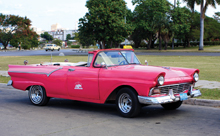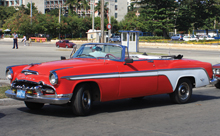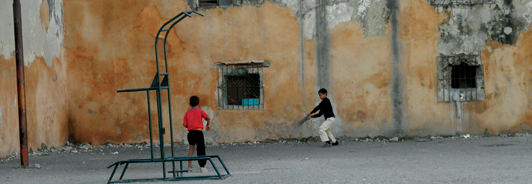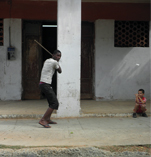Campus Scene – Voices
Signs of Capitalism Endure in Cuba
— Story by Charles O. Collins, Ph.D.
Geographers relish the remote. The allure of isolation becomes irresistible when it’s less than 100 miles from U.S. soil.
For three geographers with UNC roots, Cuba had long been professionally intriguing. When travel restrictions eased and an agency was found to navigate legal logistics, we embarked to the domain of the brothers Castro.


BASEBALL AND VINTAGE CARS: Collins captured life in Cuba from youth-improvised baseball to an assortment of vintage cars. Two of the cars are used by the government to shuttle tourists: a 1957 Ford convertible covered with pink house paint and a 1955 DeSoto convertible.
Our focus was the so-called Habana Victory Gardens, part of a strategy of urban agriculture to cope with early 1990s food shortages related to the withdrawal of Soviet aid. Despite glowing reports to the contrary, the practice was much diminished when we visited in 2010. Our alternative was to absorb as much of daily life as possible through observation, literature, photos and conversations with Cubans on the street and in academia — activities we pursued with no interference and much friendly cooperation.
Since the 16th century, Havana has been described as a gray dowager. But the city’s crumbling countenance is more than age; official policy directs funds to the countryside, especially to education and health care, and for two decades those funds have been critically scarce. Consequently, the Cuban capital contains much decay and is eerily quiet, especially at night. But in a cityscape of subdued sound and tint, we discovered sources of color and excitement — baseball, music and vintage cars. We enjoyed all three, but it was the latter that captured our professional interest.
At the Plaza de la Revolución, scene of Fidel’s marathon speeches, we spy a shiny pink 1957 Ford convertible that stands out among the few vehicles in the huge plaza. A brief conversation reveals it’s the property of the government’s official taxi company. The original V-8 engine has been replaced with something the driver doesn’t care to discuss. Up close, we see that the classic convertible has been repainted with pink house paint. The only Cubans who will scrape together enough money to rent it ($30 an hour, driver included/required) are families sacrificing for a daughter’s wedding or quinceañera. However, thousands of vintage cacharros are owned by Cubans who use them daily when fuel is available.
Later, two vehicles arrive at the plaza and fortuitously park next to each other, illustrating a before-and-after snapshot of Cuban history. In front is a pre- Revolution 1955 DeSoto convertible, again the property of the Cuban government and intended for tourists, or the rare resident with the equivalent of three month’s salary for a two-hour ride. Immediately behind it is the Russian-built Lada of the post-revolution era. It’s all the things the DeSoto is not: functional, cheap, mechanically simple, easily repaired, and very, very drab.
Our observations in Cuba beg a fundamental question: How does an iconic symbol of American capitalism survive six decades in Communist Cuba? We have only a partial answer: Cuban nostalgia, Cuban ingenuity, and the desired return of mass tourism to the island Columbus called the most beautiful in the world.
—Charles O. Collins, Ph.D., is a UNC professor of Geography. He traveled to Cuba with fellow geographers Jeffrey S. Smith (BA-88) and Jennine (Engelhardt) Pettit (BA-96).







